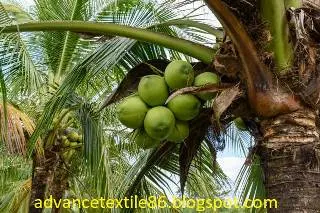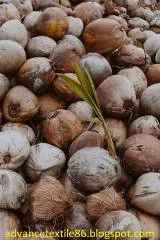Coir fiber
Coir
fiber is one of the few natural fibers that are relatively waterproof and
resistant to damage by saltwater. Both modulus and tensile strength depend
strongly on the amount of fiber and moisture. Coir fiber is a natural fiber
derived from coconut husk. Coir fiber is the densest and most resistant of all
commercial natural fibers. A low decomposition rate is the main advantage of
making sustainable products. Cords made of coir fiber were invented in the
early century. The main reason for the production of rope for centuries is the
high strength of coir fiber. There are usually two types of coir fiber after
soaking for 10 months mature coconut to brown fiber and immature
green coconut to fine white fiber. Coir fiber is the most lignin-rich natural
fiber.
The natural fiber is a good low-cost advertising option; Coir fiber is one of them.
The results showed a good absorption capacity towards methylene blue. Oxidized
coir fibers gain better efficiency in the synthesis of metal ions and can be
regenerated using alkali and reused at least three times with maximum
efficiency. White coir spun into yarn is used to make ropes and brown coir is
used in bags, brushes, doormats, rugs, mattresses, insulation panels, and
packaging.
Properties of coir fiber
i.
There are two types of coconut fiber such as brown coir fiber is extracted from
mature coconut and white coir fiber are extracted from immature coconut.
ii.
Brown coir fibers are dense, strong, and have high corrosion resistance.
iii.
White coir fibers are smooth and delicate, but also weak.
iv.
The length of the coir fiber is 6 to 8 inches.
v.
The density of coir fiber is 1.40 g / cc
vi. The tension of coir fiber is 10 g / text
vii.
Elongation of coir fiber is 30%.
viii.
The diameter of the coir fiber is 0.1 to 1.5 mm.
ix.
Swelling in water 5% along to diameter.
X. The moisture of coir fiber is 10.50%.
xi. The cellulose of coir fiber is 43.44%.
xii.
Water-soluble 5.25%.
xiii.
It is durable, absorbs water, resists sunlight, facilitates seed germination,
and is 100% biodegradable.
xiv.
Coir fiber liners are used for eco-friendly products and indoor gardens.
Chemical composition of coir fiber
Water-soluble
- 5.25%
Pectin
and related compounds - 3.00%
Hemicellulose
- 0.25%
Lignin
- 45.84%
Cellulose
- 43.44%
Ash
- 2.22%
Coir fiber manufacturing process
Ripe
and fallen coconuts can only be picked from the ground. Coconuts clinging to
trees 40-100 feet tall are cut by human climbers. If the climber carries the
fruit in his hand, he can collect the fruit from about 25 trees a day. If the climber uses a bamboo pole with a knife attached to the edge to reach the
treetop plants and loses the selected coconut, he can cut down 250 trees per
day.
Ripe
coconuts are husked immediately but can be ripe for a month without leaving
them to dry by spreading them in a single layer on the ground. To remove the
fruit from the seeds, the coconut is pressed onto the spikes with the help of
steel to split the husk. The pulp layer is easily peeled off. A skilled husker
can split manually and take about 2,000 coconut peels every day. Modern husking
machines can be processed 2,000 coconuts per hour.
Retting
is a curing process during which the husk is kept in an environment that
naturally stimulates the activity of germs. This process partially decomposes
the pulp that can be separated into coir fibers and a residue called coir pith.
The freshwater rhubarb is used for fully ripe coconut husks and the saltwater
rhubarb is used for green husks.
Typically,
the workers beat the rated pulp with wooden mallets to separate the fibers from
the peat and the outer skin. In recent years, motorized machines with flat-beat
arms have been built inside steel drums. Separation of bristle fibers is done
by hand or on a machine consisting of a rotary drum fitted with steel spikes.
Separation of mattress fiber from the pit is done by washing the residue from
the defibering process and scraping it by hand or crushing it in a perforated
drum or sieve. The clean fibers are spread loosely on the ground for drying.
Bristle
fibers that will not be further processed immediately are rolled up and tied in
loose bundles for storage or shipment. More mechanical manufacturers can use a
hydraulic press to make compact bells. Similarly, mattress fibers can only be
billed with a hydraulic press. However, if further processing is desirable, the
fibers are attached to mechanical or manual carding tools, then loosely bent
into thick yarn and wound into bundles. Later, the wick can be turned into fine
yarn again. Techniques vary from simple hand spinning to the use of a
hand-operated spinning wheel or a fully automatic spinning machine. Depending
on its final use, the yarn can be shipped to customers, or multiple strands can
be twisted into yarn and bundled for shipment.
Uses of coir fiber
i. Coir fiber is used in floor mats and doormats, brushes, mattresses, floor tiles, and sacking.
ii. It is used as an organic and decorative component in soil and potting mixes.
iii. It is used as a substrate to grow mushrooms.
iv. It can be used as a terrarium substrate for reptiles or arachnids.
v. It is also used as bedding in litter boxes, animal farms, and pet houses to absorb animal waste.
vi. Coir fiber is used as a construction material because natural fibers are eco-friendly.











0 Comments